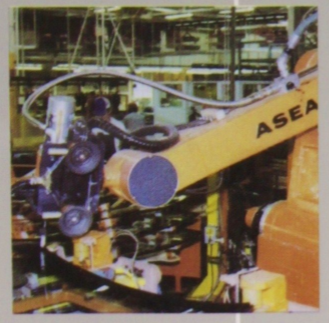
Researching the history and political economy of industrial robots for my dissertation has put the “military-industrial complex” front-and-center in my work. And like the majority of archival work, most of the devils are in the details. Most details, however, are usually quite dull: Armed Services Procurement Regulations (ASPR), Cost Accounting Standards (CAS), and Independent Research and Development (IR&D) policy. To make matters worse, the military-industrial complex, like Marx’s assessment of Communism in mid-19th century Europe, is often a specter haunting the archives, only occasionally taking concrete form. Mention of its mere existence is even rare.
Image: Industrial robot at the Chrysler Assembly Plant in Newark, Delaware, circa 1988.
Such is not the case, however, in the National Association of Manufacturers (NAM) records. In the late 1960s, NAM’s leadership, particularly those associated with the National Defense Committee (NDC), recognized that the negative connotation of the military-industrial complex was a credible threat to their members, many of whom, by the 1960s, were defense contractors or key players in the defense industry proper.[1] With anti-war activities around the country reaching a fever pitch, the NDC labored not to debate the conceptualization of the complex articulated by the anti-war movement, but rather to put a positive spin on it, arguing that the complex’s existence was necessary for the nation’s security.[2] NAM utilized a three-point media strategy of direct mailings, published articles, and sponsored lectures and talks aimed at the American public and NAM members alike. The tenor of these communications were perhaps best exemplified in a pamphlet entitled “What Eisenhower Really Said About the Military-Industrial Complex” which selected quotes from his famous farewell speech to be “qualified” in an effort to “rebuk[e] those who slur this [military] establishment”.[3]
Yet, not all NAM allies dismissed the criticisms of the anti-war movement out of hand. Speaking to the NDC at the Madison Hotel in Washington, D.C. on November 18, 1969, Ralph C. Nash, Jr., Associate Dean of the National Law Center at the George Washington University, candidly stated:
The thing that the young people are concerned about is that we, as decision-makers - the sort of aristocracy that runs this country - has turned off with regard to an awful lot of the people in our society - the black people, the poor people, the Indians ...We rotate somebody from industry into the Department of Defense, and we rotate somebody from the Department of Defense back into industry, but it's a closed circuit ...and we've got to open it.[4]
In short, researching the mundanities of the military-industrial complex - the ASPRs, CASs, and IR&Ds - can be as tedious as it sounds, but luckily, the NAM records made it much more interesting than anticipated. And every once and awhile you find a gem that makes it all worthwhile. Here’s my favorite from a speech to the National Association of Accountants given by Charles A. Dana, manager of Government Accounting Controls at Raytheon:
Accountants of Government contractors unite! You have nothing to lose but your profit reducing Cost Principles![5]
So there we have it, Karl Marx was, in fact, not a European revolutionary; he was actually an accountant for the American military-industrial complex!
[1] For a political history of the role played by defense companies and contractors in NAM’s evolution from the late 1950s through the early 1970s, see Jonathan Soffer, “The National Association of Manufacturers and the Militarization of American Conservatism,” The Business History Review, Vol. 75, No. 4 (Winter, 2001), pp. 775-805.
[2] Numerous documents from the NDC’s correspondence and meetings make this clear. See Series IV, Boxes 36-40, National Association of Manufacturers records (1411).
[3] “What Eisenhower Really Said About the Military-Industrial Complex”, undated, Series IV, Box 37, Folder - Military-Industrial Complex, 1967-1970, National Association of Manufacturers records (1411).
[4] “What the Nation Expects from its Civilian and Military Guardians: An Address”, 18 Nov. 1969, Series IV, Box 37, Folder - Military-Industrial Complex, 1967-1970, National Association of Manufacturers records (1411).
[5] C.A. Dana speech to the National Association of Accountants, 14 Nov. 1966, Box 36, Folder - National Defense Committee Mailing, 1969-1970, National Association of Manufacturers records (1411).
Salem Elzway is a PhD candidate in the History Department at the University of Michigan
